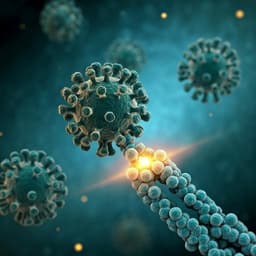
Medicine and Health
A broad neutralizing nanobody against SARS-CoV-2 engineered from an approved drug
Q. Liu, Y. Lu, et al.
Discover VHH60, a groundbreaking neutralizing nanobody that competes with human ACE2 to inhibit SARS-CoV-2 infection. Developed by an expert team, this nanobody shows superior protective capabilities against both ancestral and variant strains, showcasing a rapid approach to therapeutic innovation.
~3 min • Beginner • English
Introduction
The study addresses the urgent need for therapeutics that remain effective against rapidly evolving SARS-CoV-2 variants that escape existing antibodies and vaccines. SARS-CoV-2 uses the Spike (S) glycoprotein to bind ACE2 via its receptor-binding domain (RBD), and blocking this interaction can prevent infection. Due to continual emergence of variants with mutations in Spike (e.g., E484K, N501Y, D614G; variants including Alpha, Beta, Gamma, Delta, Omicron and sublineages), there is a pressing demand for broadly neutralizing agents. Nanobodies (single-domain antibodies, VHHs) offer advantages such as small size, stability, ease of production, and low immunogenicity. The authors propose a rapid, safe, and efficient strategy to engineer neutralizing nanobodies directly from the framework of an approved nanobody drug (caplacizumab), hypothesizing that such engineered VHHs can achieve potent and broad neutralization against SARS-CoV-2, including variants, and can be generated faster than traditional immunization-based antibody discovery.
Literature Review
The introduction summarizes structural and mechanistic knowledge of SARS-CoV-2 Spike-mediated entry, including the roles of TMPRSS2, cathepsins, and Furin, and conformational changes of the S trimer. Prior studies reveal increased ACE2 affinity and immune escape conferred by mutations such as E484K, N501Y, and D614G and by variant constellations (e.g., Alpha, Beta, Gamma, Delta, Omicron lineages), leading to reduced neutralization by some antibodies and vaccine sera. Nanobodies have been developed as therapeutics across diseases, with one (caplacizumab) approved clinically, highlighting the druggability of the VHH scaffold. Existing SARS-CoV-2 nanobodies (e.g., VHH72) can potently neutralize betacoronaviruses, and multivalent formats can enhance potency. This background motivates engineering and screening of nanobody libraries to find broad neutralizers without animal immunization.
Methodology
Template and library engineering: The approved nanobody caplacizumab served as the framework. Complementarity-determining regions (CDR1, CDR2, and the highly variable CDR3 loop and flanking region) were diversified based on natural VHH repertoires. In CDR3, 18 amino acids (biased frequencies; excluding stop codons, C, and M) were allowed with loop lengths from 6 to 17 residues. Diversity was introduced by oligonucleotide-directed mutagenesis using degenerate codons (CDR1/2) and trimer phosphoramidites (CDR3) on a uracil-containing single-stranded DNA template, followed by in vitro synthesis and ligation, electroporation into E. coli ER2738, helper phage rescue, and PEG/NaCl precipitation, yielding a phage display VHH library (~10^10 variants; 75–90% carrying mutations in all three CDRs).
Biopanning and primary screening: Three rounds of solid-phase panning against recombinant RBD-Fc coated on 96-well plates were performed. Bound phages were eluted (glycine-HCl pH 2.2), neutralized, amplified, and re-selected. Single colonies were screened by phage ELISA; 78 unique VHH genes were identified. VHHs were assembled into mammalian expression cassettes (CMV promoter; human IgG1 Fc fusion) via overlapping PCR and transiently expressed (ExpiCHO/293F). Culture supernatants containing Fc-tagged VHHs were used in a blocking ELISA to assess competition with human ACE2 for RBD binding; VHH72-Fc served as positive control.
Expression and purification: Fc-tagged proteins were purified by protein A chromatography (elution with acetic acid pH 3.5; neutralization with Tris-HCl pH 9.0). His-tagged proteins were purified by Ni-affinity chromatography (HisTrap; imidazole elution). Additional hydroxyapatite polishing achieved >95% HPLC purity when required. Purity was assessed by SDS-PAGE and HPLC (TSKgel G3000SWXL). RBD (319–531) was produced in baculovirus/Sf9 with His-tag, PNGaseF deglycosylation, tag removal, and ion exchange cleanup.
Binding assays: ELISA measured VHH binding to RBD-Fc and EC50 values. Surface plasmon resonance (Biacore 8K; Protein A sensor chip) captured Fc-VHHs and flowed RBD under concentration gradients to derive kinetics/affinities (1:1 model). Competition SPR assessed ACE2 binding after RBD engagement with VHHs. HTRF assays quantified ACE2-RBD disruption.
Neutralization assays: Pseudovirus (HIV-1 or VSV backbones encoding luciferase) displaying wildtype or mutant/variant S was incubated with serially diluted VHHs and used to infect Caco-2 cells. Luciferase activity at 48–72 h post-infection was measured; IC50 values calculated by nonlinear regression. Live-virus assays used ancestral SARS-CoV-2 (IVCAS 6.7512) incubated with VHHs, added to Vero E6 cells for 24 h, followed by TRIzol inactivation, RNA extraction, cDNA synthesis, and qRT-PCR targeting N gene; genome copies normalized to GAPDH.
In vivo efficacy: Female K18-hACE2 transgenic mice (9–10 weeks) were injected intraperitoneally with VHHs (0.5 mg/kg) or vehicle 24 h prior to intranasal challenge with 6×10^4 PFU ancestral SARS-CoV-2. Mice were monitored for survival and body weight up to 6 days post-infection (dpi). Subsets (n=5/group) were sacrificed at 3 dpi for lung viral load (plaque assay/qPCR), immunofluorescence (ACE2 and nucleocapsid), and histopathology (H&E). Remaining mice were observed for survival and weight loss; euthanasia criteria were predefined (20% weight loss).
Structural studies: Cryo-EM of prefusion-stabilized WT S trimer in complex with VHH60 revealed a 1-up RBD conformation with one VHH60 bound (overall map resolution 3.79 Å). Data were collected on Titan Krios with K3 detector; processed in cryoSPARC (motion correction with MotionCor2; CTF estimation; 2D/3D classification; non-uniform refinement). The model was built using 6VSB and the crystal structure as templates in Coot/Phenix. X-ray crystallography of RBD(319–531)-VHH60 complex yielded a 3.40 Å structure; molecular replacement used PDB 7VNB and a VHH model; refined in Phenix and Coot. Interface mapping identified contacts and hydrogen bonds at residues Y351, T470, E471, Q493, and S494 on RBD.
Multivalency engineering: A His-tagged trimeric VHH60 (Tri-VHH60-His) was generated; ACE2-RBD blocking and pseudovirus neutralization potencies were compared to monomeric VHH60.
Key Findings
- Discovery of VHH60, an engineered nanobody derived from the caplacizumab framework, that binds the SARS-CoV-2 RBD with 2.56 nM affinity and competes with ACE2 at an overlapping epitope (RBD residues approximately 351 and 470–471, 493–494).
- Binding/competition: Multiple selected VHHs blocked ACE2-RBD interaction by ELISA and SPR. Although VHH35 showed highest affinity by SPR (Kd ~0.54 nM), it was less effective functionally, indicating binding affinity alone does not predict neutralization potency.
- Pseudovirus neutralization (Caco-2): VHH60 IC50 = 13.96 ± 2.42 nM (better than VHH72-Fc at 26.34 ± 5.19 nM and comparable/superior to ACE2-Fc at 16.81 ± 5.06 nM). VHH35 ~100 nM IC50.
- Live ancestral SARS-CoV-2 (Vero E6): VHH60 IC50 = 1.87 ± 0.35 nM versus VHH72 11.17 ± 1.58 nM (≈6-fold improvement).
- In vivo prophylaxis (K18-hACE2 mice, 0.5 mg/kg IP pre-challenge): Vehicle group (5/5) died at 4 dpi; VHH60 and VHH72 groups survived to 6 dpi, with one death at 5 dpi in VHH60 group. VHH60 reduced lung viral titers at 3 dpi by ~45-fold versus vehicle and ~9-fold versus VHH72; mice showed less weight loss and improved lung histopathology and reduced nucleocapsid signal by immunofluorescence.
- Variant breadth: VHH60 inhibited pseudoviruses with single S mutations (E484K, N501Y, D614) at nanomolar IC50 and showed robust inhibition of Omicron subvariants BA.1, BA.2, and BA.3 at nanomolar levels, comparable to or better than wildtype S.
- Structural mechanism: Cryo-EM (3.79 Å) and crystal (3.40 Å) structures show VHH60 binds the RBD using CDR2 and CDR3; the epitope overlaps the ACE2 footprint (RBD 437–508), causing steric hindrance with ACE2 and explaining competitive blocking. Key RBD contacts include Y351, T470, E471, Q493, and S494, residues largely conserved among variants (with Q493R in Omicron subsequently reverting to R493Q in BA.4/BA.5).
- Multivalency: Trimeric VHH60 (Tri-VHH60-His) improved ACE2-RBD blocking potency by ~9-fold (IC50 ~33.57 nM in blocking assay) and enhanced pseudovirus inhibition ~9-fold compared to monomeric VHH60.
Discussion
The study demonstrates that a rapid nanobody engineering strategy based on a clinically validated VHH framework can yield potent, broad SARS-CoV-2 neutralizers without animal immunization. VHH60 effectively blocks ACE2-RBD interaction through an epitope overlapping the ACE2 binding site, as verified structurally, translating into strong in vitro and in vivo antiviral efficacy. The disconnect between highest binding affinity (e.g., VHH35) and neutralization potency underscores the importance of epitope location and competition with ACE2 over affinity alone. VHH60 maintains nanomolar inhibition against key escape mutations and Omicron sublineages (BA.1–BA.3), indicating resilience to prevalent antigenic changes likely due to targeting conserved RBD residues that remain functionally constrained. The prophylactic mouse study shows significant reductions in lung viral titers, delayed mortality, and improved pathology, supporting the biological relevance of ACE2-competitive binding. Multivalent formatting further boosts potency, suggesting that engineering avidity and combining complementary epitopes (e.g., VHH60 with inner-face binders like VHH72) could produce synergistic cocktails with enhanced breadth and barrier to resistance. Collectively, the findings validate both the therapeutic potential of VHH60 and the broader platform for fast response to emerging pathogens.
Conclusion
VHH60, an engineered nanobody derived from the approved caplacizumab scaffold, exhibits strong binding to SARS-CoV-2 RBD, broadly neutralizes wildtype and variant pseudoviruses at nanomolar concentrations, potently inhibits live virus in vitro, and confers significant prophylactic protection in a K18-hACE2 mouse model. Structural analyses reveal an ACE2-overlapping epitope explaining its competitive blocking mechanism and breadth. The work showcases a rapid, safe discovery pipeline—eschewing animal immunization—that can accelerate countermeasure development for future pandemics. Future directions include optimization of multivalent formats (e.g., trimers or Fc-fusions), combination nanobody cocktails targeting non-overlapping RBD sites to enhance breadth, comprehensive pharmacokinetic and safety profiling, expanded testing against emergent variants, therapeutic (post-exposure) efficacy studies, and advancement toward clinical development.
Limitations
- The in vivo study used prophylactic administration at a single dose (0.5 mg/kg) with short observation (up to 6 dpi); therapeutic (post-exposure) efficacy, dose-response, and extended survival were not assessed.
- Pharmacokinetics, tissue distribution, immunogenicity, and safety/toxicity profiles were not reported.
- Variant testing was performed in pseudovirus systems for select mutations and Omicron sublineages (BA.1–BA.3); comprehensive live-virus breadth against diverse and newer lineages was not shown.
- Affinity and blocking were largely characterized with recombinant proteins; developability attributes beyond initial purification (e.g., stability, aggregation under stress, manufacturability at scale) were not detailed.
- Human clinical data are absent; translation to human efficacy remains to be established.
Related Publications
Explore these studies to deepen your understanding of the subject.







